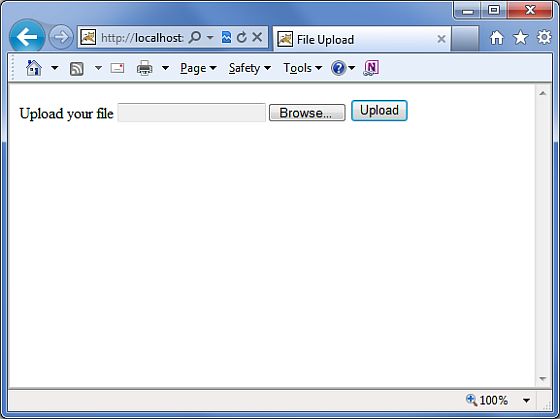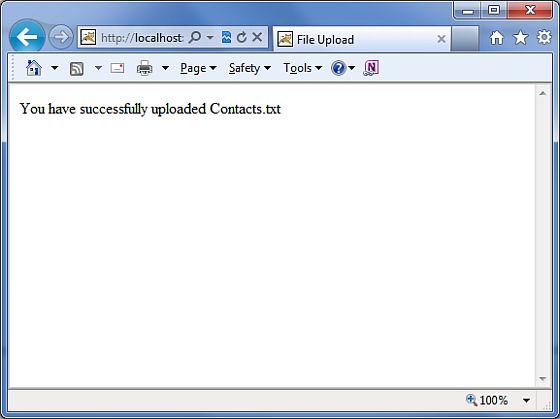Struts2文件上傳
Struts2框架提供了內置支持處理文件上傳使用“基於表單的文件上傳HTML“。當一個文件被上傳時,它通常會被保存在一個臨時目錄中,他們應該被處理或你的Action類的永久目錄,以確保數據不會丟失。
需要注意的是服務器可能有一個安全的地方政策,禁止你寫屬於您的Web應用程序的臨時目錄和目錄以外的目錄。
在Struts的文件上傳是通過一個預定義的文件上傳攔截器的攔截器,這是通過org.apache.struts2.interceptor.FileUploadInterceptor類的defaultStack。你依然可以使用,在您的struts.xml中設置不同的參數研究,正如我們將在下麵看到的那樣。
創建視圖文件:
讓我們開始創建我們認為這將需要瀏覽和上傳選定的文件。所以,讓我們創建一個index.jsp的,與普通的HTML上傳表單,允許用戶上傳文件:
<%@ page language="java" contentType="text/html; charset=gbk"
pageEncoding="ISO-8859-1"%>
<%@ taglib prefix="s" uri="/struts-tags"%>
<!DOCTYPE html PUBLIC "-//W3C//DTD HTML 4.01 Transitional//EN"
"http://www.w3.org/TR/html4/loose.dtd">
<html>
<head>
<title>File Upload - by www.gitbook.net</title>
</head>
<body>
<form action="upload" method="post" enctype="multipart/form-data">
<label for="myFile">Upload your file</label>
<input type="file" name="myFile" />
<input type="submit" value="Upload"/>
</form>
</body>
</html>
有在上述示例中值得注意的幾個百分點。首先,所有的表單的enctype屬性設置為multipart/form-data。這應該是設置,以便成功地處理文件上傳文件上傳攔截器。第二點值得注意的是表單action方法上傳的文件上傳字段的名稱 - 這是MYFILE。我們需要這些信息來創建的操作方法和Struts配置。
接下來,讓我們創建一個簡單的jsp文件success.jsp情況下,它成為成功的結果顯示我們的文件上傳。
<%@ page contentType="text/html; charset=UTF-8" %> <%@ taglib prefix="s" uri="/struts-tags" %> <html> <head> <title>File Upload Success</title> </head> <body> You have successfully uploaded <s:property value="myFileFileName"/> </body> </html>
以下將結果文件error.jsp的情況下,有一些錯誤,在上傳文件:
<%@ page contentType="text/html; charset=UTF-8" %> <%@ taglib prefix="s" uri="/struts-tags" %> <html> <head> <title>File Upload Error</title> </head> <body> There has been an error in uploading the file. </body> </html>
創建動作類:
接下來,讓我們創建一個Java類,稱為uploadFile.java這會管理上傳文件,該文件存儲在一個安全的位置:
package com.tutorialspoint.struts2;
import java.io.File;
import org.apache.commons.io.FileUtils;
import java.io.IOException;
import com.opensymphony.xwork2.ActionSupport;
public class uploadFile extends ActionSupport{
private File myFile;
private String myFileContentType;
private String myFileFileName;
private String destPath;
public String execute()
{
/* Copy file to a safe location */
destPath = "C:/apache-tomcat-6.0.33/work/";
try{
System.out.println("Src File name: " + myFile);
System.out.println("Dst File name: " + myFileFileName);
File destFile = new File(destPath, myFileFileName);
FileUtils.copyFile(myFile, destFile);
}catch(IOException e){
e.printStackTrace();
return ERROR;
}
return SUCCESS;
}
public File getMyFile() {
return myFile;
}
public void setMyFile(File myFile) {
this.myFile = myFile;
}
public String getMyFileContentType() {
return myFileContentType;
}
public void setMyFileContentType(String myFileContentType) {
this.myFileContentType = myFileContentType;
}
public String getMyFileFileName() {
return myFileFileName;
}
public void setMyFileFileName(String myFileFileName) {
this.myFileFileName = myFileFileName;
}
}
uploadFile.java是一個非常簡單的類。最重要的事情需要注意的是,文件上傳攔截器的參數Intercetpor一起做所有繁重的。文件上傳攔截器默認情況下,為您提供三個參數。它們被命名為以下模式:
-
[your file name parameter] - 這是實際的用戶已經上傳的文件。在這個例子中,這將是 "myFile"
-
[your file name parameter]ContentType - 這是上載的文件的內容類型。在此示例中,這將是 "myFileContentType"
-
[your file name parameter]FileName - 這是被上傳的文件,該文件的名稱。在此示例中,這將是 "myFileFileName"
這三個參數都為我們提供的,這要歸功於Struts的攔截器。所有我們必須做的是正確的名稱在我們的Action類,自動地將這些變量是為我們創建三個參數。所以,在上麵的例子中,我們有三個參數和操作方法簡單地返回“success”,如果一切順利,否則返回“error”。
配置文件:
以下是Struts2的配置屬性來控製文件的上傳過程:
| SN | Properties & Description |
|---|---|
| 1 |
struts.multipart.maxSize The maximum size (in bytes) of a file to be accepted as a file upload. Default is 250M. |
| 2 |
struts.multipart.parser The library used to upload the multipart form. By default is jakarta |
| 3 |
struts.multipart.saveDir The location to store the temporary file. By default is javax.servlet.context.tempdir. |
為了改變這些設置,您可以在您的應用程序struts.xml文件中使用常量標簽,所做的更改要上傳的文件的最大值。在struts.xml中如下:
<?xml version="1.0" encoding="UTF-8"?>
<!DOCTYPE struts PUBLIC
"-//Apache Software Foundation//DTD Struts Configuration 2.0//EN"
"http://struts.apache.org/dtds/struts-2.0.dtd">
<struts>
<constant name="struts.devMode" value="true" />
<constant name="struts.multipart.maxSize" value="1000000" />
<package name="helloworld" extends="struts-default">
<action name="upload" class="com.tutorialspoint.struts2.uploadFile">
<result name="success">/success.jsp</result>
<result name="error">/error.jsp</result>
</action>
</package>
</struts>
由於文件上傳攔截器的攔截器defaultStack的一部分,我們並不需要明確地配置。但您可以添加<interceptor-ref>的標簽內<action>。文件上傳攔截器需要兩個參數(a)maximumSize (b)allowedTypes。 maximumSize 參數設置允許的最大文件大小(默認為約2MB)。allowedTypes參數是一個逗號分隔的列表接受的內容類型(MIME),如下圖所示:
<action name="upload" class="com.tutorialspoint.struts2.uploadFile">
<interceptor-ref name="basicStack">
<interceptor-ref name="fileUpload">
<param name="allowedTypes">image/jpeg,image/gif</param>
</interceptor-ref>
<result name="success">/success.jsp</result>
<result name="error">/error.jsp</result>
</action>
以下是web.xml文件中的內容:
<?xml version="1.0" encoding="UTF-8"?>
<web-app xmlns:xsi="http://www.w3.org/2001/XMLSchema-instance"
xmlns="http://java.sun.com/xml/ns/javaee"
xmlns:web="http://java.sun.com/xml/ns/javaee/web-app_2_5.xsd"
xsi:schemaLocation="http://java.sun.com/xml/ns/javaee
http://java.sun.com/xml/ns/javaee/web-app_3_0.xsd"
id="WebApp_ID" version="3.0">
<display-name>Struts 2</display-name>
<welcome-file-list>
<welcome-file>index.jsp</welcome-file>
</welcome-file-list>
<filter>
<filter-name>struts2</filter-name>
<filter-class>
org.apache.struts2.dispatcher.FilterDispatcher
</filter-class>
</filter>
<filter-mapping>
<filter-name>struts2</filter-name>
<url-pattern>/*</url-pattern>
</filter-mapping>
</web-app>
現在,右鍵點擊項目名稱,並單擊“導出”> WAR文件創建一個WAR文件。然後,這WAR部署在Tomcat的webapps目錄下。最後,啟動Tomcat服務器,並嘗試訪問URL http://localhost:8080/HelloWorldStruts2/upload.jsp。這會給你以下畫麵:

現在選擇一個文件Contacts.txt,”瀏覽“按鈕,然後點擊上傳按鈕,將上傳的文件,應該看到網頁以下圖示。可以查看上傳的文件保存在 C:\apache-tomcat-6.0.33\work.

請注意,文件上傳攔截器刪除上傳的文件會自動打開,在某個位置目錄,它被刪除之前保存上傳的文件。
錯誤消息:
fileUplaod攔截器使用幾個默認的錯誤消息鍵:
| SN | Error Message Key & Description |
|---|---|
| 1 |
struts.messages.error.uploading A general error that occurs when the file could not be uploaded. |
| 2 |
struts.messages.error.file.too.large Occurs when the uploaded file is too large as specified by maximumSize. |
| 3 |
struts.messages.error.content.type.not.allowed Occurs when the uploaded file does not match the expected content types specified. |
您可以覆蓋這些消息的文本中WebContent/WEB-INF/classes/messages.properties資源文件。

